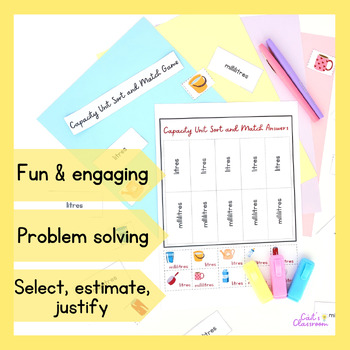Math Lesson Plan │Units of Capacity Hands-On Activities/Worksheets│5th/6th Grade
- Zip
Also included in
- 5th/6th grade end of year math fun! Looking for a complete unit on liquid volume and capacity measured in liters and milliliters? Want it to include step-by-step lesson plans, hands-on measurement activities, digital presentations/software, engaging games and practice worksheets? Then this resourcePrice $18.00Original Price $25.75Save $7.75
- 5th/6th grade end of year math fun! Preparing to teach metric weight and capacity? From liters and milliliters to tons and kilograms, this unit features hands-on measurement games/activities, digital/printable resources and detailed lesson plans.Designed specifically with newly qualified teachers inPrice $29.70Original Price $45.68Save $15.98
Description
Searching for a fun, engaging lesson for fifth/sixth grade on liters and milliliters? Want it to include hands-on estimation activities, games/worksheets, a digital presentation and real-world problem solving scenarios? Then this resource is for ✨️YOU!✨️
Take the stress out of creating complete lesson plans and resources! This lesson includes a capacity unit sort and match game, a main activity on estimating capacity, problem solving scenarios for selecting and justifying units of capacity and a digital presentation promoting maths talk in the classroom.
This resource includes UK and US spellings and is also aligned with both CCSSM and the Irish Primary Mathematics Curriculum (2023) for seamless integration into planning documents. ✏️
Say goodbye to weekends planning on your laptop and hello to an engaged classroom – grab your copy TODAY!
⭐️Benefits⭐️
✅️Reduces planning demands on teachers, saving valuable time and effort while being well-designed and aligned with curriculum standards.
✅️Offers a complete, low-prep resource with step-by-step instructions, ideal for newly qualified teachers who want support teaching math to the senior grades.
✅️Enhances conceptual understanding and procedural fluency in estimating, selecting and justifying appropriate units of capacity measurement.
⭐️In Depth Description⭐️
This 45-minute lesson plan includes:
✅️Capacity Unit Sort and Match game cards: Reinforces understanding of capacity units through hands-on gameplay.
✅️Estimation Station worksheets (color and black & white): Facilitates reflection on estimation skills and capacity concepts.
✅️Problem-solving scenario worksheets (color and black & white): Challenges students' critical thinking and application of capacity concepts in real-life situations, fostering problem-solving abilities and deeper understanding.
✅️Math Talk digital presentation: Provides a clear focus for math discussions, encouraging student participation and collaboration.
✅️3 learning objectives: Clearly defines lesson outcomes, guiding both teachers and students in their learning goals.
✅️Differentiation strategies: Accommodates diverse learning needs, ensuring all students can access and succeed in the lesson.
✅️Assessment strategies: Provides practical guidance on assessing student understanding throughout the lesson.
✅️Key vocabulary and definitions: Equips students with essential language for effective communication about liquid volume and capacity concepts.
✅️Exit tickets (color and black & white): Quickly gauges student understanding at the end of the lesson, providing valuable feedback for future instruction.
✅️ Fully aligned with the new Irish Primary Mathematics Curriculum (2023), specifically the element of reasoning and the competencies of being well, being an active citizen and being a communicator and using language.
✅️Common Core aligned - CSS.MP.1, CSS.MP.2, CSS.MP.3.
⭐️Other Uses⭐️
- Math Centers: Use the Capacity Unit Sort and Match game cards and Estimation Station worksheets as math center activities, providing students with additional practice and reinforcement of capacity concepts in a self-directed manner.
- Homework Extensions: Assign the problem-solving worksheets as homework extensions, encouraging students to apply their capacity knowledge to real-life scenarios outside of the classroom and fostering independent problem-solving skills.
- Vocabulary Review: Use the Key vocabulary and definitions as a vocabulary review activity, engaging students in activities such as matching games or vocabulary quizzes to reinforce their understanding of essential capacity terminology.
➡️ Don't let this opportunity slip away! Elevate your teaching experience and engage your students - secure your complete lesson plan and resources TODAY! ⬅️
Click here to join the Cáit's Classroom mailing list for valuable tips, tricks, and special offers designed to support newly qualified teachers in effectively teaching maths to 3rd-6th class students.
Related Products
⭐ Capacity & Liquid Volume│Math Lesson Plan Hands-on Activities Worksheets│5th/6th
⭐ Comparing Capacity│Lesson Plan,Hands-on Activities,Worksheets│5th/6th Grade Math
⭐ Converting Capacity│Lesson Plan,Hands-on Activities,Worksheets│5th/6th Grade Math
⭐ Liquid Volume & Capacity │5-Day Unit│Lessons Worksheets Games Activities 5th/6th







